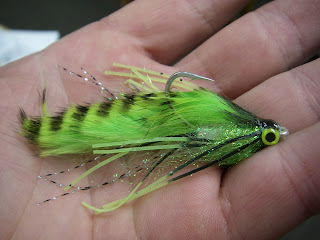 As you have probably gathered, we at the shop are not dry-fly purists...nor are we exclusive to trout. We spend a exorbitant amount of time fishing and developing new (and occasionally better) flies for saltwater and warmwater. Most of these flies are what can be lumped into the streamer fly category. "Streamer" is a very general term encompassing a wide variety of flies tied to imitate shad, young trout and sculpin to crayfish and leeches.
As you have probably gathered, we at the shop are not dry-fly purists...nor are we exclusive to trout. We spend a exorbitant amount of time fishing and developing new (and occasionally better) flies for saltwater and warmwater. Most of these flies are what can be lumped into the streamer fly category. "Streamer" is a very general term encompassing a wide variety of flies tied to imitate shad, young trout and sculpin to crayfish and leeches.We have an almost daily conversation here at the fly shop about new streamer designs and ideas (sometime on the bazaar side...if someone left the lid off the jar of Softex!). Part of our morning routine, apart from flipping the lights on and the OPEN sign by the front door and getting the coffee going...is dumping the fruits of our previous nights tying labors onto the conference table to be perused through and criticized by our co-workers. This very honest feed back (sometimes brutally honest) and constructive exchange of theories and ideas is maybe the best perk of working and being fully submersed into the flyfishing industry.
The biggest questions of a new streamer are always, "How does it look in the water?"
 and "Does it ride right?".
and "Does it ride right?".The most valuable tool a streamer guy can have is a test tank! You never want to waist time on more than one prototype if the first fly acts weird or doesn't keel correctly. At the shop we keep a small aquarium full of water for this purpose. At home I use the kitchen sink, or the bath tub. I can only justify filling up the tub if I have a bunch of different prototypes that have already passed the shop tank or sink tests...and I have the time to jump in for a soak when I'm done! (Another damn good reason to crimp your barbs!)
The most mountainous obstacles to overcome present themselves to the streamer tyer when they are attempting to "flip the hook" or make the fly ride hook up. This enables the fly to be fairly snag resistant and often the other materials will cover the hook, making the fly appear more lifelike. The best ways to achieve this has always been some sort of counterbalance, usually in the form of a dumbbell (although, Rob Kolanda has devised a technique using tungsten nymph body weights to do the same thing). The object is to put more weight on the top of the hook shank than the weight of the entire hook bend, spear and barb. This can be relatively easy to do on light weight hooks such as the Tiemco 8089 and the Gamakatsu SC15, but very difficult on super heavy hooks such as the Tiemco 800s and the Dai-Riki 810.

Two tricks I have learned for dealing with severe cases of Sideways Fly are the "lift kit" and the "eye tweak". The lift kit is a technique using two strips of lead wire to be tied between the eye and the hook shank to push more of a dumb bell's weight away from the center of gravity. This is sometimes necessary when you are tying with a preformed Real-Eye from Spirit River, because they have very skinny arbours, unlike cast lead dumbbells that have fat arbours. This skinny arbour actually allows some of the weight of the eyes themselves to be on the wrong side of the hook shank.
The eye tweak is nothing more than taking a pair of pliers and turning a normally straight eye hook into a down turned eye. This ensures the line will always be coming down to the fly at a 45 degree angle, helping the fly behave correctly. (However, I do not recommend doing this to a Dai-Riki hook. They are too brittle.)
One final thought for those of you getting creative on the vise...AVOID chenille, estaz and any other pre-made body wrap material! These things are unarguably trite. You want your new creations to have a sexy, lifelike and original appearance. Learn to use a dubbing loop to build your own streamer bodies.
If you found this article interesting, check out the comments below...there is some excellent stuff contributed by good friend Evan Jones (author of Fly Fishing in Patagonia).
No comments:
Post a Comment
Note: Only a member of this blog may post a comment.